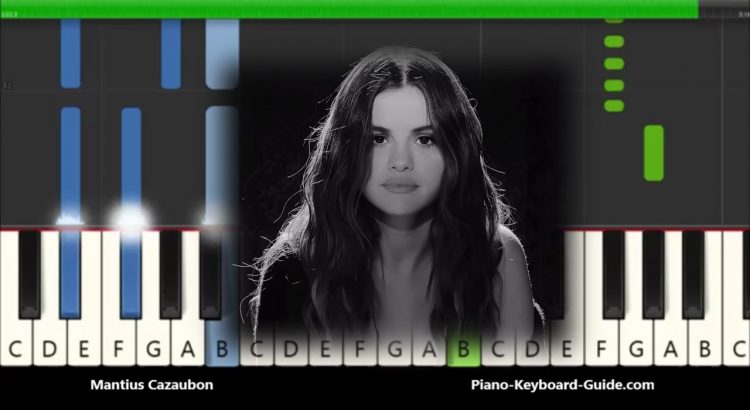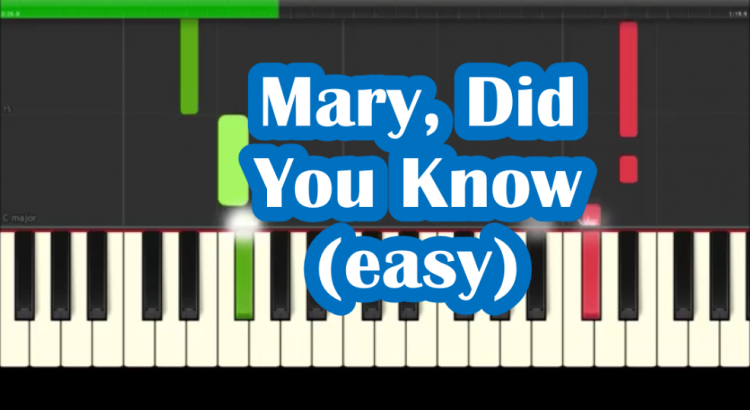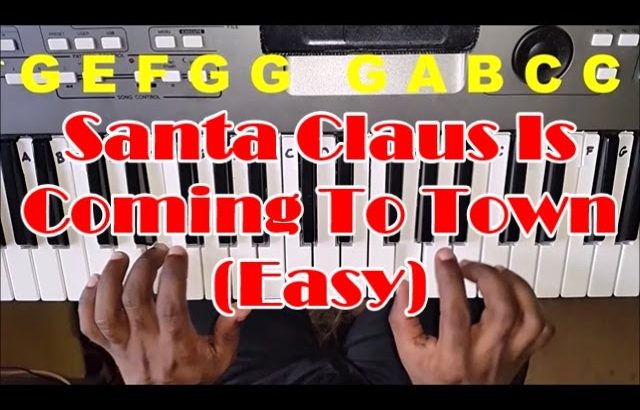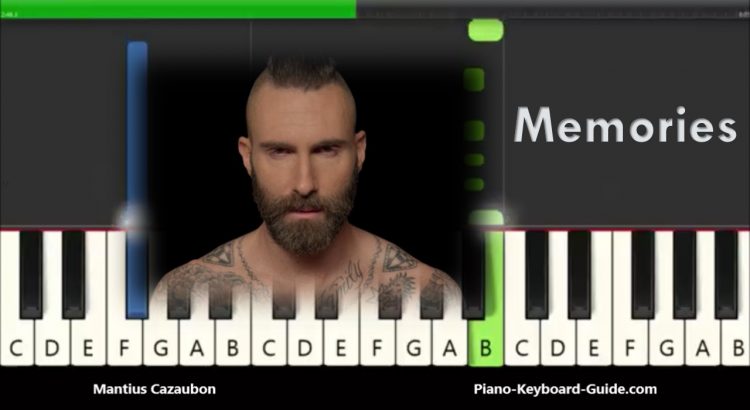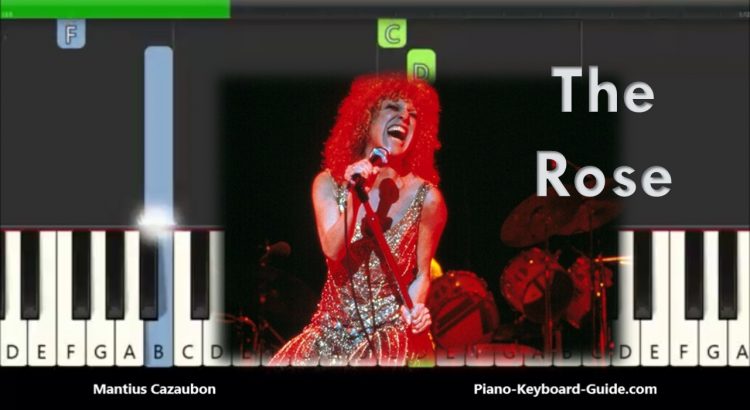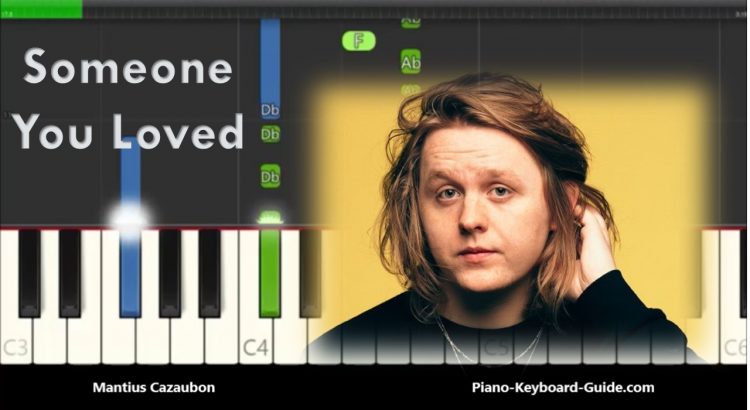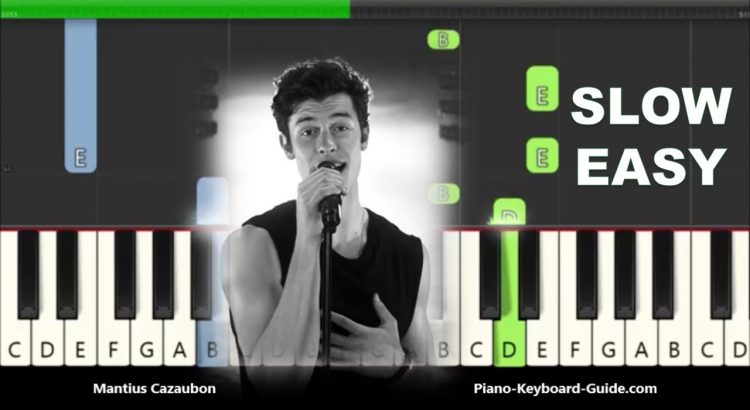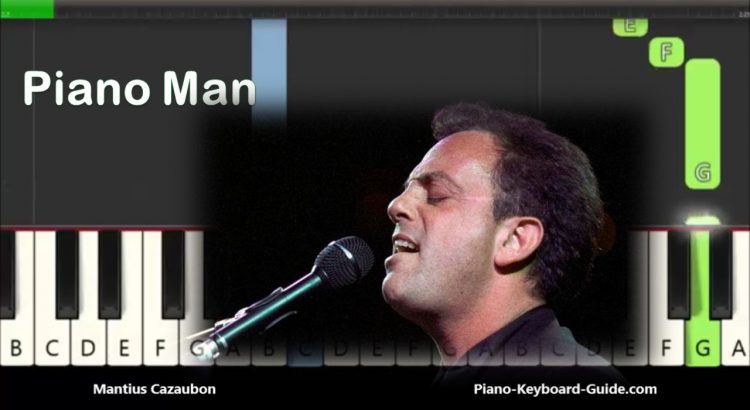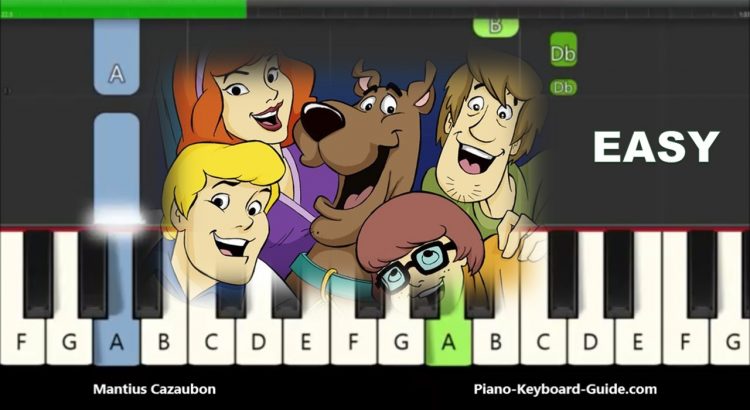How to Read Sheet Music – Basic Music Theory Lesson for Beginners
While learning to read music is like learning a completely new language, it’s really not as complicated as it may seem. In this lesson, I will show you how easy it is to learn to read and play music on any instrument. I will break down the language of music into easy to follow steps that are perfect for the beginner, or the musician who is in search of a refresher lesson on how to read notes.
The Staff
The first thing we will take a look at is what is called the staff. Take a look at the staff below. You will notice that it consists of five parallel lines and four spaces between them. Each of these lines and spaces represent a different letter which in turn represents a different note. In other words, there are various line notes and space notes. Another way to put it is that each line or space is named after a different note. The musical alphabet consists of only 7 letters. These letters are A, B, C, D, E, F and G.
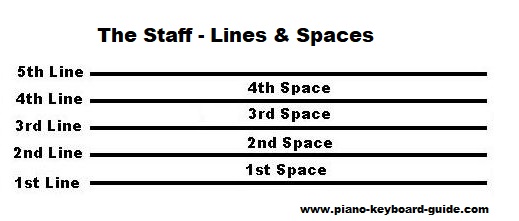
To learn how to read music, check out my course, How To Read Music Fast.
Watch this lesson (How to Read Sheet Music):
The Grand Staff
There are two clefs that you should know about. They are the treble clef and bass clef. These two clefs make up the grand staff.
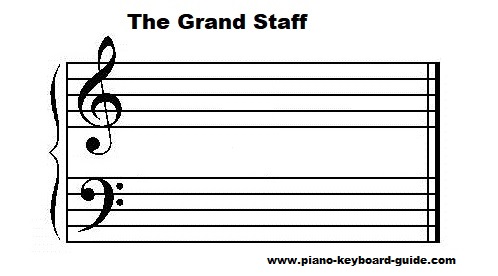
The lines and spaces of either clef are numbered from bottom to top; the bottom line is the first line and the top line is the fifth line.
The Treble Clef
Let’s take a look at the treble clef. This clef, also known as the G clef, is derived from an ornamental Latin letter G. The line at the center of the treble clef circles the line that represents the note, G. This is the second line (from the bottom).
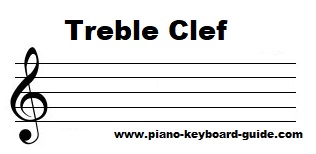
Treble Clef Line Notes
How are the lines of the treble clef named? The five lines of the treble clef, from bottom to top represent the notes, E G B D F. To make E G B D F easier to remember various word cues are often used. They include the popular, Every Good Boy Does Fine.
Treble Clef Space Notes
How are the spaces of the treble clef named? The four spaces of the treble clef, from bottom to top represent the notes, F A C E. This one is so much easier to remember because it spells the word, face.
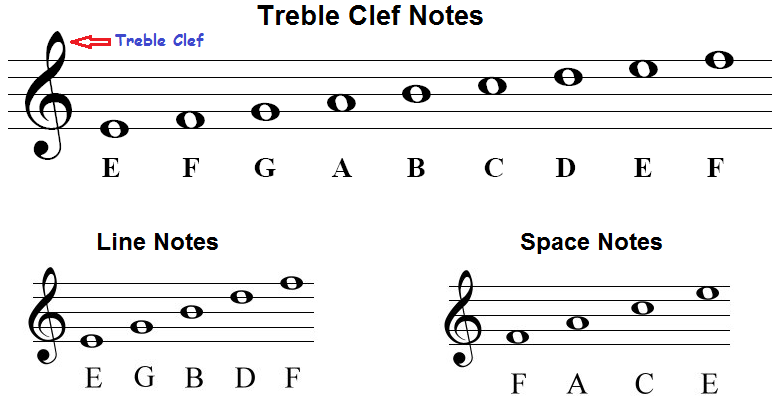
Recite the names of the notes of the treble clef from the bottom up: E G B D F. Do the same for the notes of the spaces of the treble clef: F A C E. Keep practicing and commit these notes to memory.
The Bass Clef
Let’s now take a look at the bass clef. This clef follows the same logic as the treble clef, but the location of the notes is different. The bass clef is also known as the F clef. This symbol originates from the Gothic letter F. The dots of the F clef are on either side of the F line or fourth line.
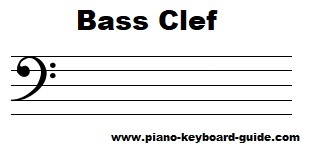
Bass Clef Line Notes
How are the lines of the bass clef named? The five lines of the bass clef, from bottom to top represent the notes, G B D F A. To make G B D F A easier to remember, certain word cues are often used. They include the popular, Good Boys Do Fine Always.
Bass Clef Space Notes
How are the spaces of the bass clef named? The four spaces of the bass clef, from bottom to top represent the notes, A C E G. To make A C E G easier to remember, certain phrases are used. They include the popular, All Cows Eat Grass.
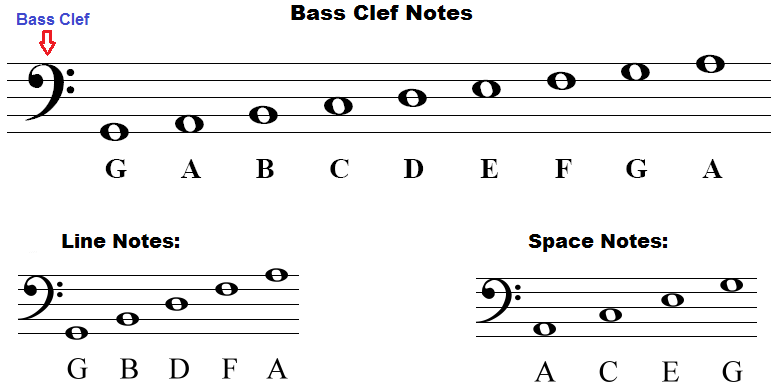
Recite the names of the notes of the bass clef from the bottom up: G B D F A. Do the same for the notes of the spaces of the bass clef: A C E G. Keep practicing and commit these notes to memory.
Ledger (Leger) Line Notes
A ledger line is used to notate pitches above or below the lines and spaces of the musical staff. A line a bit longer than the note head is drawn parallel to the staff, above or below. These short lines are spaced at the same distance as the lines of the staff. Ledger lines are nothing more than a continuation of the staff.
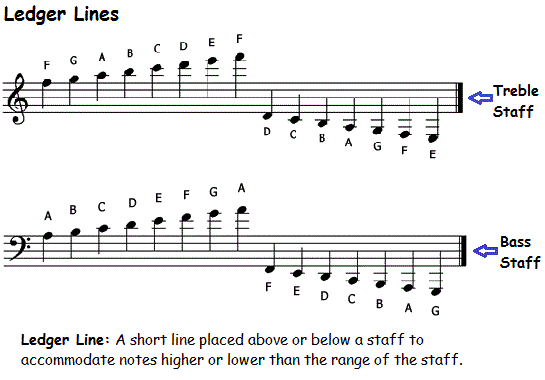
Middle C is the note halfway between the bass clef and the treble clef.
To learn how to read sheet music, check out my course, How To Read Music Fast.
Notes
Notes represent the pitch and duration of a sound. In other words, when you see a note on the staff, it’s telling you what note letter to play on your musical instrument and for how long you should play it.
Note symbols are a combination of up to three basic parts: the note head, the stem and the flag.
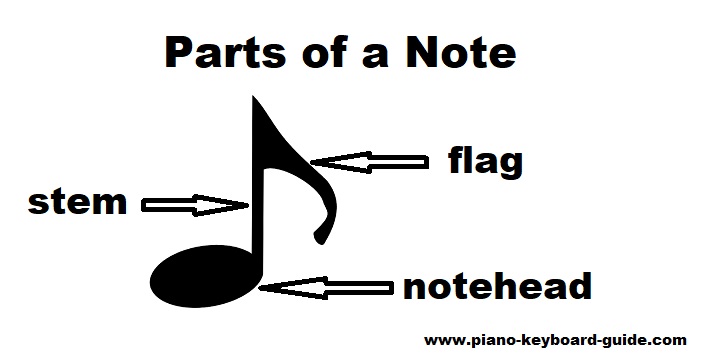
The notehead is the oval part of the note. There are two types: hollow noteheads and solid note heads. Where the note head sits on the staff tells you what note you should play on your instrument. Whether it is hollow (open) or solid (filled) indicates duration.
The stem is a vertical line attached to some notes. These lines point either upwards or downwards. The stems usually point down for notes on the middle line of the staff or higher, and up for those below. If the note is pointing upwards, the stem is located on the right, if the note points downwards, the stem is located on the left. Not all notes have stems.
The other part of a note you should know about is the flag. A note flag is the little line that comes off the top or bottom of the note stem. Flags indicate the duration of notes. Some notes have one flag while others have more than one. The more flags a note has, the shorter its duration. Some notes have no flags.
Types of Notes (Note Values or Duration)
Let’s now take a look at 5 different types of notes or note values. Each of these notes have different durations. In other words, they tell the performer how long the note should be held for.
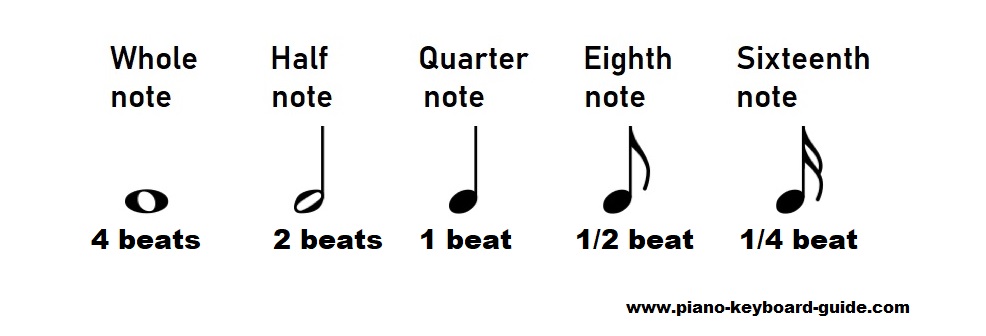
The Quarter Note (British name: Crotchet)
Let’s start with the quarter note (or crotchet). Quarter notes are notated with a filled-in oval note head and a straight, flagless stem. This note lasts one beat. A quarter note is played for one quarter of the duration of a whole note (or semibreve). Therefore, four quarter notes equal one whole note.
The Half Note (British name: Minim)
A half note (or minim) is a note played for half the duration of a whole note and twice the duration of a quarter note. This note lasts two beats. Therefore, two half notes equal one whole note. Half notes consist of a hollow oval notehead like a whole note and straight note stem with no flags like a quarter note.
The Whole Note (British name: Semibreve)
A whole note (or semibreve) is a note equivalent to or lasting as long as two half-notes or four quarter-notes. It lasts four beats. The whole note has a note head in the shape of a hollow oval like a half note but with no note stem.
The Eighth Note (British name: Quaver)
An eighth note (or quaver) lasts for half a beat. It is played for one eighth the duration of a whole note. It is half the duration of a quarter note, one quarter the duration of a half note and one eighth the duration of a whole note. The eighth note amounts to twice the value of the sixteenth note (semiquaver). Eighth notes are notated with an oval, filled-in note head and a straight note stem with one flag. Eight 8th notes make up one whole note.
The Sixteenth Note (British name: Semiquaver)
A sixteenth note (or semiquaver) is a note played for half the duration of an eighth note. Sixteenth notes are notated with an oval, filled-in note head and a straight note stem with two flags. A single sixteenth note is always stemmed with flags, while two or more are usually beamed together. Sixteen 16th notes make up one whole note.
Counting Notes
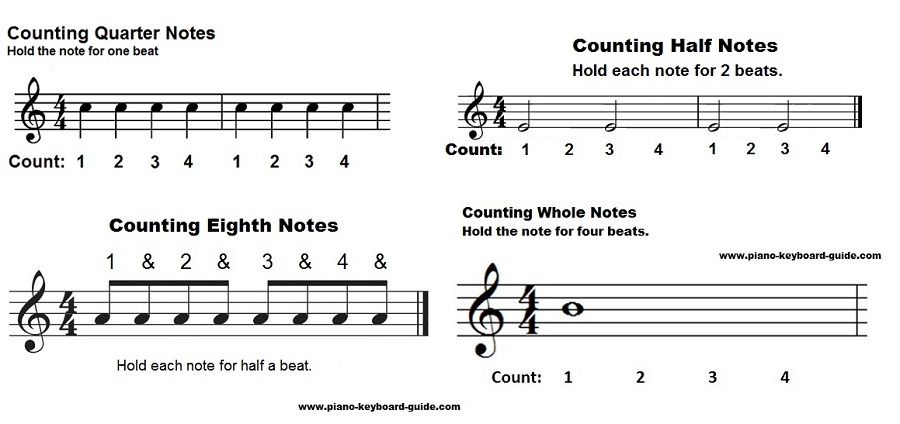
Count 1 2 3 4, 1 2 3 4, 1 2 3 4, 1 2 3 4 in your mind. Clap on each number. These are quarter notes. Go to your piano or other instrument and play a note on each beat. Each note lasts one beat. These are all quarter notes.
Count 1 2 3 4, 1 2 3 4, 1 2 3 4, 1 2 3 4 in your mind. Clap on numbers 1 and 3. You’re counting half notes. Go to your instrument and play a note on beats 1 and 3. Each note lasts two beats. These are all half notes.
Count 1 2 3 4, 1 2 3 4, 1 2 3 4, 1 2 3 4. Clap only on number 1. You’re counting whole notes. Go to your instrument and play a note on beat 1. Each note lasts four beats. These are all whole notes.
To play eighth notes, instead of 1 2 3 4, 1 2 3 4, 1 2 3 4, count 1 & 2 & 3 & 4 &, 1 & 2 & 3 & 4 &, 1 & 2 & 3 & 4 &, 1 & 2 & 3 & 4 &. Clap on each number as well as & (and). Go to your piano or other instrument and instead of clapping, play notes on every number as well as “and”. Each note lasts half a beat. These are all eighth notes.
Sixteenth notes are twice as fast as eighth notes. For sixteenth notes, use the syllables, 1-e-and-ah, 2-e-and-ah, 3-e-and-ah, 4-e-and-ah, 1-e-and-ah, 2-e-and-ah, 3-e-and-ah, 4-e-and-ah, 1-e-and-ah, 2-e-and-ah, 3-e-and-ah, 4-e-and-ah, 1-e-and-ah, 2-e-and-ah, 3-e-and-ah, 4-e-and-ah. Each note lasts one quarter of a beat.
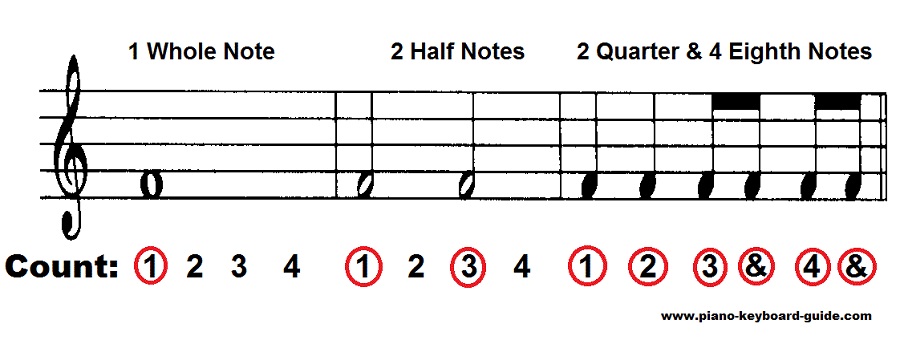
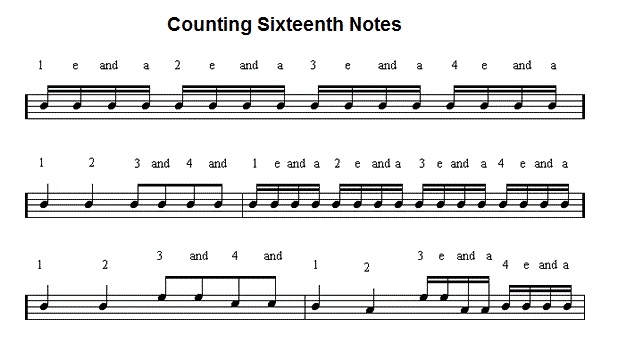
One whole note = 2 half notes = 4 quarter notes = 8 eighth notes = 16 sixteenth notes.
Dotted Notes
We will now take a look at dotted notes. To make a note last longer, a dot is often added. A dot increases the duration of a note by half its value. For example, a dot after a quarter dot means that you should play a note for 1 + 1/2 a beat (1 and a half beats). A dot after a half note means that you should play the note for 2 beats plus half its value, which equals to three beats. A dotted whole note means that you should play a note for 4 + 2 beats = 6 beats.
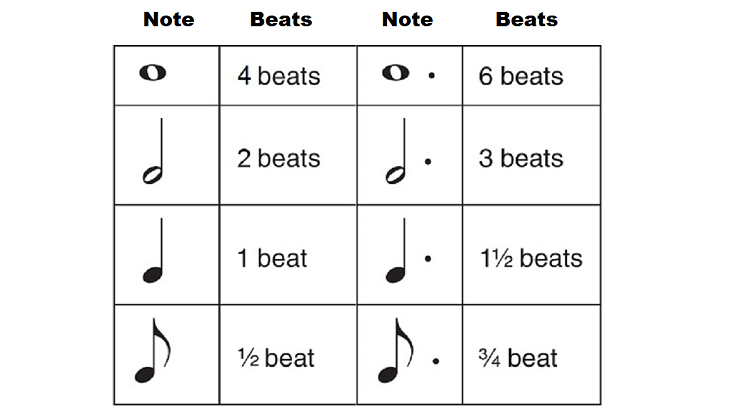
Ties
A tie is a curved line that connects the heads of two notes of the same pitch, indicating that you should add the duration of each note together and play them as a single note. For instance, if there’s a tie connecting a half note and a quarter note, you are to hold that note for three beats. If there’s a tie connecting a quarter note and a whole note together, the note lasts for 5 beats.
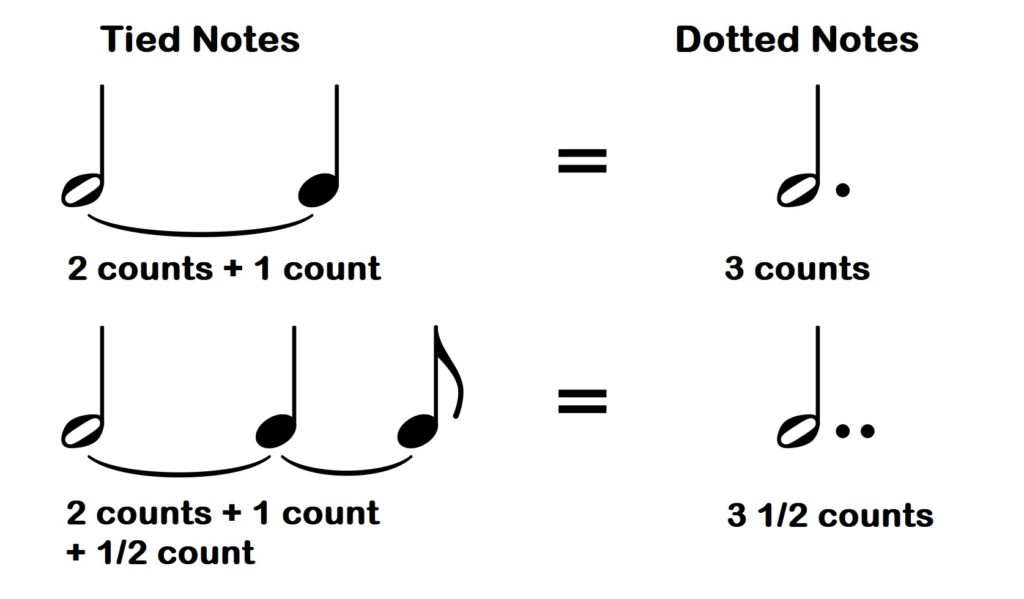
Rests
To tell a musician when to play, different types of notes are used. But what happens when we want to tell the musician not to play a note? To indicate this, you use a symbol called a rest. A rest in music is a symbol that indicates that there should be a period of silence. Every type of note has a corresponding rest symbol that has the same time value. Types of rest include the quarter rest (or crotchet rest) which lasts for one beat, the half rest (or minim rest) which lasts for two beats and the whole rest (or semibreve rest) which lasts for four beats. Similar to an eighth note, an eighth rest (or quaver rest) lasts for half a beat and just like a sixteenth note, a sixteenth rest (or semiquaver rest) lasts for a quarter of a beat.

Like notes, rests can also be dotted, indicating that the rest lasts for one a half times its duration. For instance, a dotted half rest lasts for three beats, while a dotted whole rest lasts for 6 beats.
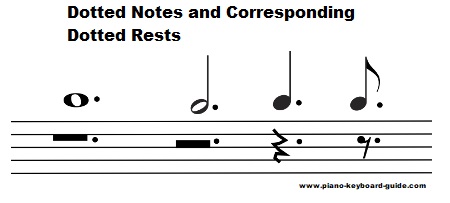
Measures
Vertical black bars called barlines divide the staff into measures. A measure is the section of a staff that comes between two barlines.

Time Signatures
Time signatures consist of two numbers, one stacked above the other. The bottom tells you the note value that represents one beat, while the top number indicates how many such beats constitute a measure. For instance, a 3/4 time signature tells you that there are 3 quarter note beats per measure and a quarter note gets one beat. A 4/4 time signature tells you that there are 4 quarter note beats per measure and a quarter note gets one beat.
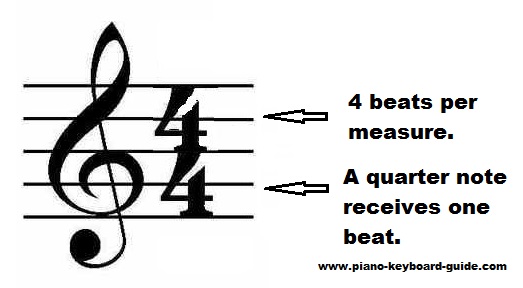
Here’s Twinkle Twinkle Little Star. Use this sheet music to better understand how to read music.
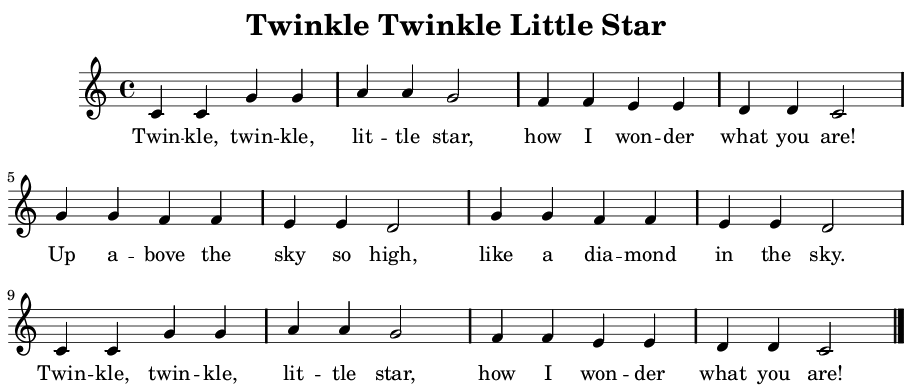
Tempo
Another thing you should know about is tempo. Tempo is the speed or pace of a given piece. The tempo of a song is measured in beats per minute (or BPM). BPM indicates the number of beats in one minute. For instance, a tempo of 60 BPM means that a beat sounds exactly once per second. A 120 BPM tempo is twice as fast, with two beats per second.
To take your ability to read music to the next level, check out my course, How To Read Music Fast.
The C Major Scale
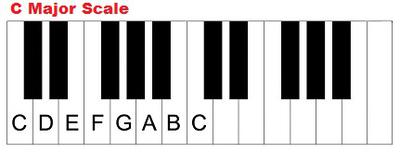
Let’s talk about scales. A major scale is made up of 8 consecutive notes. Typically, the first scale one learns is the C major scale. Its notes are C D E F G A B C. The last C in the scale is a repetition of the first C at a higher octave. On piano, the C major scale consists of white keys only. When you understand the C major scale, it’s easier to understand the other major scales, like the F major scale, G major scale and so on.
Here’s the C major scale:

Whole Steps (Whole Tones) and Half Steps (Semitones)
A half step (or semitone) on a piano keyboard is the distance from one note to the next note. A whole step (or whole tone) is made up of two half steps. For instance the distance between E and F is a half step; there is no key between E and F. The distance between C and D is a whole step; there is one key between C and D. More on whole steps and half steps (whole tones and semitones).
The major scale formula is whole step, whole step, half step, whole step, whole step, whole step, half step or W-W-H-W-W-W-H. To play a C major scale, you start on C and move one whole step to D, one whole step to E, one half step to F, one whole step to G, one whole step to A, one whole step to B and one half step to C.
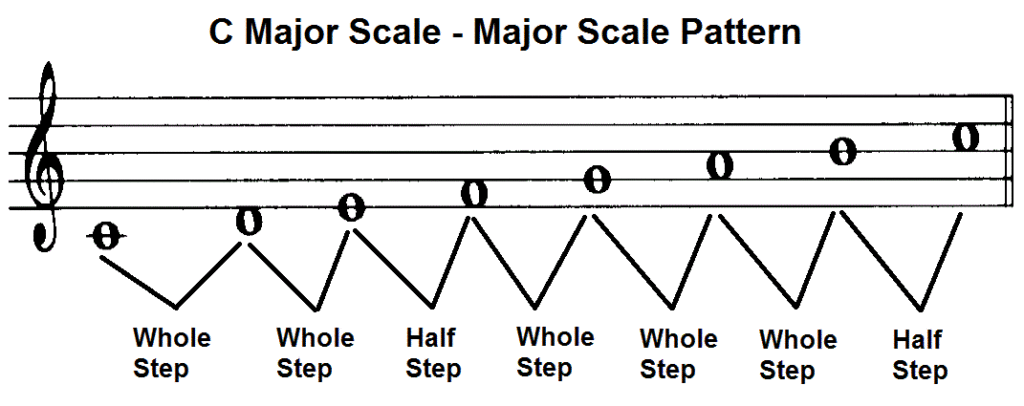
Accidentals: Sharps, Flats and Naturals
Sharps, flats and naturals are called accidentals.
Sharps
A sharp sign (♯) means to play a note that is a half step or semitone higher. For instance, C♯ (C sharp) means to play the note that is a half step higher than C. On piano, you simply play the key that is to the immediate right of C. F♯ (F sharp) means to play the note that is a half step higher than F. On piano, you simply play the key that is to the immediate right of F. Usually, a hashtag (pound or number sign) is used to represent the sharp sign when typing or writing. For instance, instead of D♯, you can simply type D#.
Flats
In music, the opposite of a sharp sign is a flat sign (♭). A flat sign means to play a note that is a half step or semitone lower. For instance, D♭ (D flat) means to play the note that is a half step lower than D. On piano, you simply play the key that is to the immediate left of D. G♭ (G flat) means to play the note that is a half step lower than G. On piano, you simply play the key that is to the immediate left of G. Usually, a small letter “b” is used to represent the flat sign when typing or writing. For instance, instead of D♭, you can simply type Db.
Diagram of Piano Keys and Notes
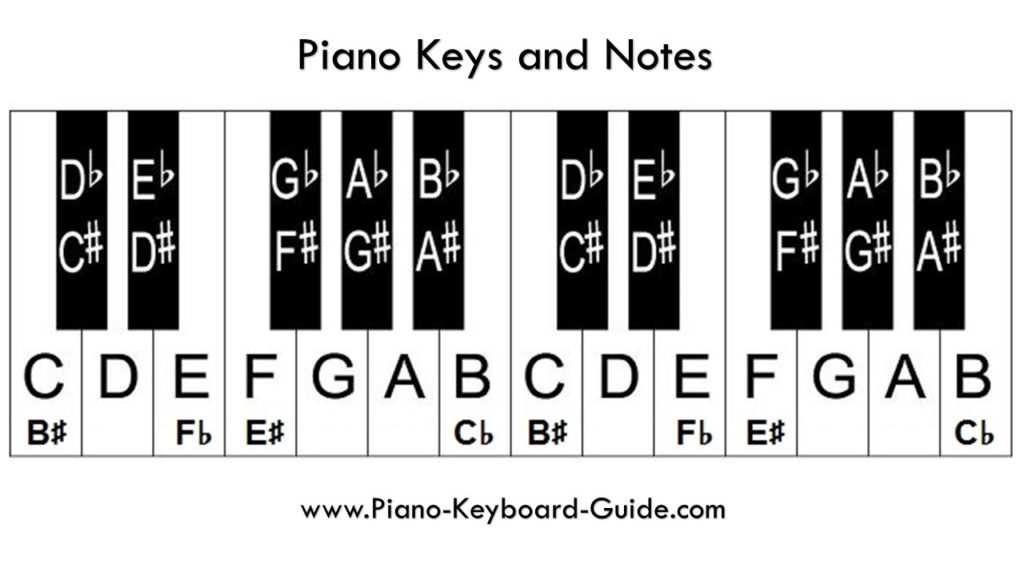
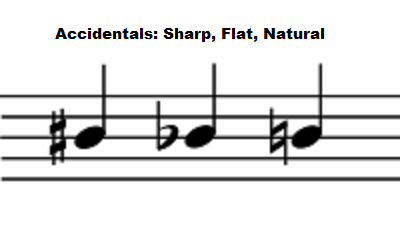
Naturals
A natural sign (♮) is used to cancel a flat or sharp from either a preceding note or the key signature. For example, if a previous note in a piece of music is Bb, when a natural symbol precedes the new note, the note, B must be played. In this case, the natural sign cancels the flat. Here’s another example: The key of G has one sharp, F#. To indicate that you should play F and not F#, a natural sign will be placed before the note. In this case, the natural sign cancels the sharp.
Key Signatures
A key signature is a set of sharp (♯) or flat (♭) symbols placed on the staff at the beginning of a section of music. It is placed immediately after the clef. In a key signature, a sharp or flat symbol on a line or space of the staff indicates that the note represented by that line or space is to be played a half step higher (sharp) or half step lower (flat) than it would otherwise be played.
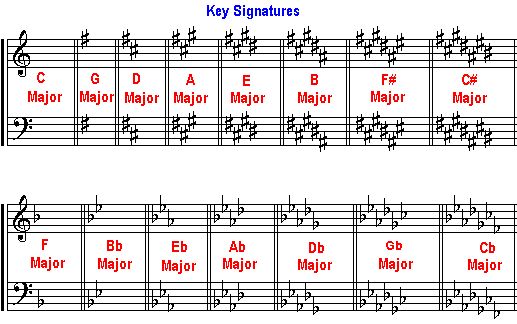
Key Signatures with Sharps
A key signature tells you in what key a song is played. If there are no sharps or flats, the song is in the key of C major, one sharp: G major, two sharps: D major, three sharps: A major, four sharps: E major, five sharps: B major, six sharps: F sharp major and seven sharps: C# major.
Key Signatures with Flats
For key signatures with flats, one flat indicates the key of F major, two flats: Bb major, three flats: Eb major, four flats: Ab major, five flats: Db major, six flats: Gb major and seven flats: Cb major.
Major key with no sharps or flats: C
Major key with sharps: G, D, A, E, B, F♯, C♯
Major Key with flats: F, B♭, E♭, A♭, D♭, G♭, C♭
For much more detail and to take your reading ability to the next level, check out my Udemy course, How To Read Music Fast.
Related pages:
